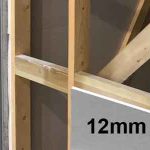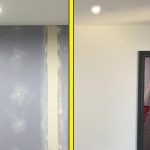Plasterboard is a very common building material in modern homes. It can be installed in a variety of different ways, and it can be used on both walls and ceilings.
It is also available in a wide variety of sizes and thickness. Some of the most common sizes for plasterboard are:
- 2400mm x 1200mm
- 2400mm x 900mm
- 1800mm x 900mm
- 1220mm x 900mm
Out of these sizes, 2400mm x 1200mm is by far the most popular. This is mainly because it gives the largest coverage and means less joints in the finished surface. Smaller boards are generally used where access is slightly more difficult.
There are also other less common sizes for plasterboard. However, these are the most common, and you will find them in most builder’s merchants and DIY stores.
When it comes to plasterboard thickness, there are several options available. By far the most common, are 9.5mm and 12.5mm.

If you are applying plaster board to walls, the board size you choose is quite simple. In most situations, 2400mm x 1200mm is usually the best choice. If you are going to struggle with this size, or if you just don’t need as much, you can use a smaller, more appropriate size for the job.
As we mentioned previously, when it comes to thickness, you have two main choices, 9.5 or 12.5mm. Thicker boards are available, but they are less common.
12.5mm plasterboard is definitely the best choice for walls. It creates a much more solid wall, when compared with 9.5mm plasterboard. It also has several other advantages, including, better fire rating, better insulation values, and better acoustic values.
Why 12.5mm is the best thickness for walls – Explained
Below you can see some more detailed reasons why 12.5mm plasterboard are the best choice when it comes to boarding a wall:
- A more robust and rigid finish – A 12.5m board is over 30% thicker than a 9.5mm board. This makes a lot of difference in the finished strength of the wall. Often with a thinner board, you can easily feel the flex and wobble in the surface.
- Less chance of damage to plaster – This ties in with the previous point. Due to less potential movement, it is far less likely to see cracks in 12.5mm boards. This happens far more easily on plastered board joints in a 9.5mm plasterboard.
- Better fire rating – In areas where fire protection is required, 12.5mm boards give roughly 30 minutes of protection. This is in line with minimum legal requirements for surfaces that must be fire rated. Therefore, 9.5 mm boards are not suitable in areas where fire protection is required.
- Better acoustic values – The level of sound reduction from 12.5mm boards vs 9.5mm boards is significant. This is especially true in stud walls that are boarded either side, as this adds an additional 6mm of plasterboard.
- More sizes, and variations – 12.5 mm is the most popular thickness. Therefore it tends to have the widest variety of sizes. Also, if you are looking for specialist boards to improve fire resistance, moisture resistance, sound proofing, etc. These types of specialist board are all in 12.5mm or higher. You will not find these in a 9.5mm variation.
As you can see there are a number of reasons that 12.5 boards are better for walls. However, there are certain situations where you could opt for a 9.5mm board.
When could you use a 9.5mm plasterboard
9.5 mm boards are far more lightweight and flimsier, compared with thicker boards. This makes them less suitable on walls in most areas. However, there are situations where they can offer a good alternative to a thicker board.
Any area that does not have a requirement for extra fire or acoustic protection, may be suitable for 9.5mm boards this could include smaller rooms such as storage cupboards, utility rooms and any other area where space is tight could benefit from this type of thinner plasterboard.
Another area where 9.5mm boards is popular are ceilings. This is mainly due to the boards being around 5-6kg lighter, which makes them easier to handle overhead. It is also cheaper, so many people will choose this when boarding ceilings.
However, it is still prone to more movement. As a result, there is a slightly higher risk of plaster cracking along joints, but only if there is movement in the ceiling from the floor above.
One important thing to remember, is fire regulations. If the building you are boarding has fire safety requirements, it I unlikely that a 9.5mm board will be acceptable. This would include areas such as:
- Commercial premises
- Flats or apartment buildings
- HMO’s
- And any other building that has strict fire regulations.
Even if fire regulations don’t affect the area you are boarding, it is still worth considering. The difference in price between 9.5 and 12.5mm is going to be minimal. But the quality is going to be far superior with a thicker board.
Even boarding a ceiling isn’t that much harder with a slightly heavier board. It is still a two-man job and if you use some kind of prop or board lift, it will make very little difference to the installation process. Personally I would always use 12.5mm boards on a ceiling
Conclusion
In 90% of cases a 12.5mm board is the best choice for walls. It gives an all-round better-quality finish to the wall. Not only will it be sturdier, but it ill also be more fire and sound resistant. This should give you more peace and peace of mind.




